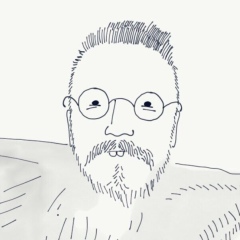ЕФИМОВ В. ПУТИ ВЫХОДА РОССИИ ИЗ ЭКОНОМИЧЕСКОГО КРИЗИСА
Тезисы к видеозаписи выступления.
Наша экономика неразумна. Рубль эмитируется под доллар. Доллар - это товар.
Деньги, на самом деле, не могут быть предметом спекуляций. Миф: деньги - это кровь экономики. В реальности, деньги - это вагоны для транспортировки товаров. Они не должны сосредоточиваться в чьих-то руках. Они должны жечь руки. Для этого существует механизм отрицательного ссудного процента. Сейчас главными держателями денег являются банки. Но они им не нужны.
Устойчивость валюты обеспечивается исключительно товарной массой государства и добавленной стоимостью, которая в государстве создаётся. Чем глубже переработка сырья до готового продукта, тем выше добавленная стоимость. Тем больше рабочих мест.
Современный финансовый сектор - это высокие прибыли, а товара под эти прибыли нет.
Сейчас в некоторых государствах Европы нулевая ставка ссудного процента и отрицательный депозит. У нас: депозит до +19%. И не облагается налогом. Сельское хозяйство - труд тяжёлый. Рентабельность в России -5%. С дотациями +7,5%. Зачем работать в поте лица за 7,5%, если можно лежать на диване и получать 19%.
Доходы банков велики. А Госдума выделяет ещё на поддержку банков. Денежная база растёт. Но реальный сектор кредитуется под 20-30%. При доходности в 7% в с/х. Иностранцы удивляются, как Россия ещё жива.
Есть исторический опыт. Менделеев в работе "С думой о благе российском" анализировал 100 лет в экономике Российской империи с 1761 по 1861 годы. Цены неуклонно снижались. А в 1883 году появился Крестьянский земельный банк, который выдавал кредиты на 34,5 года под 7,5% годовых. Но эти 7,5% - это погашение и процентов по кредиту и тела ссуды. Т.е., через 34,5 года заёмщик полностью расплачивался с кредитом. Результат: Россия производила зерна больше, чем США, Аргентина и Канада в совокупности.
Откуда взять деньги на развитие производства? Надо посчитать, сколько требуется для обеспечения демографически обусловленных потребностей человека. Умножить на 150 млн. населения и выдать одномоментно. Но не долговыми расписками (современный рубль), а деньгами государственного банка России. Также поступить и с производственными потребностями и с социальными (госзакупки и т.д.). Но эти деньги должны быть с коротким сроком жизни (например, 1 месяц). Потом эти деньги обнуляются (с электронными деньгами это сделать просто). И сделать это один раз. Будет запущен механизм развития промышленности. После этого вводится энергоинвариант. Статистика энергопотребления для каждого населённого пункта - это показатель динамики промышленного развития. И это показатель того, сколько денег должно быть в экономике.
У независимого государства, по определению, не может не хватать денег. Кровь экономики - это ресурсы и товарные потоки. Деньги - это отражённый свет того, что у вас есть в реальности. Деньги - это информация. Их просто надо напечатать под имеющуюся товарную массу (или в электронном виде). Сталин это понимал. У него не возникало вопроса: откуда взять денег, когда в стране проводилась индустриализация. В течение 5 лет было запущено 1500 строек промышленных предприятий. А к 1940 году заработало 9000 предприятий.
Тезисы к видеозаписи выступления.
Наша экономика неразумна. Рубль эмитируется под доллар. Доллар - это товар.
Деньги, на самом деле, не могут быть предметом спекуляций. Миф: деньги - это кровь экономики. В реальности, деньги - это вагоны для транспортировки товаров. Они не должны сосредоточиваться в чьих-то руках. Они должны жечь руки. Для этого существует механизм отрицательного ссудного процента. Сейчас главными держателями денег являются банки. Но они им не нужны.
Устойчивость валюты обеспечивается исключительно товарной массой государства и добавленной стоимостью, которая в государстве создаётся. Чем глубже переработка сырья до готового продукта, тем выше добавленная стоимость. Тем больше рабочих мест.
Современный финансовый сектор - это высокие прибыли, а товара под эти прибыли нет.
Сейчас в некоторых государствах Европы нулевая ставка ссудного процента и отрицательный депозит. У нас: депозит до +19%. И не облагается налогом. Сельское хозяйство - труд тяжёлый. Рентабельность в России -5%. С дотациями +7,5%. Зачем работать в поте лица за 7,5%, если можно лежать на диване и получать 19%.
Доходы банков велики. А Госдума выделяет ещё на поддержку банков. Денежная база растёт. Но реальный сектор кредитуется под 20-30%. При доходности в 7% в с/х. Иностранцы удивляются, как Россия ещё жива.
Есть исторический опыт. Менделеев в работе "С думой о благе российском" анализировал 100 лет в экономике Российской империи с 1761 по 1861 годы. Цены неуклонно снижались. А в 1883 году появился Крестьянский земельный банк, который выдавал кредиты на 34,5 года под 7,5% годовых. Но эти 7,5% - это погашение и процентов по кредиту и тела ссуды. Т.е., через 34,5 года заёмщик полностью расплачивался с кредитом. Результат: Россия производила зерна больше, чем США, Аргентина и Канада в совокупности.
Откуда взять деньги на развитие производства? Надо посчитать, сколько требуется для обеспечения демографически обусловленных потребностей человека. Умножить на 150 млн. населения и выдать одномоментно. Но не долговыми расписками (современный рубль), а деньгами государственного банка России. Также поступить и с производственными потребностями и с социальными (госзакупки и т.д.). Но эти деньги должны быть с коротким сроком жизни (например, 1 месяц). Потом эти деньги обнуляются (с электронными деньгами это сделать просто). И сделать это один раз. Будет запущен механизм развития промышленности. После этого вводится энергоинвариант. Статистика энергопотребления для каждого населённого пункта - это показатель динамики промышленного развития. И это показатель того, сколько денег должно быть в экономике.
У независимого государства, по определению, не может не хватать денег. Кровь экономики - это ресурсы и товарные потоки. Деньги - это отражённый свет того, что у вас есть в реальности. Деньги - это информация. Их просто надо напечатать под имеющуюся товарную массу (или в электронном виде). Сталин это понимал. У него не возникало вопроса: откуда взять денег, когда в стране проводилась индустриализация. В течение 5 лет было запущено 1500 строек промышленных предприятий. А к 1940 году заработало 9000 предприятий.
EFIMOV V. WAYS TO EXIT RUSSIA FROM THE ECONOMIC CRISIS
Abstracts for videotape performances.
Our economy is unreasonable. The ruble is issued under the dollar. A dollar is a commodity.
Money, in fact, can not be the subject of speculation. Myth: Money is the blood of the economy. In reality, money is wagons for transporting goods. They should not be concentrated in the hands of anyone. They must burn their hands. To do this, there is a mechanism of negative interest loan. Now the main holders of money are banks. But they do not need them.
The stability of the currency is provided exclusively by the mass of commodities of the state and the value added that is created in the state. The deeper the processing of raw materials to the finished product, the higher the added value. The more jobs.
The modern financial sector is high profits, but there is no product for these profits.
Now in some European countries zero interest rate and a negative deposit. We have: deposit up to + 19%. And is not taxed. Agriculture is hard work. Profitability in Russia -5%. With subsidies + 7.5%. Why work hard for 7.5% if you can lie on the couch and get 19%.
Revenues of banks are great. And the State Duma allocates more to support banks. The monetary base is growing. But the real sector is credited at 20-30%. With a yield of 7% in agriculture. Foreigners wonder how Russia is still alive.
There is a historical experience. Mendeleev in his work “With the thought about the good of the Russian” analyzed 100 years in the economy of the Russian Empire from 1761 to 1861. Prices steadily declined. And in 1883 the Peasant Land Bank appeared, which issued loans for 34.5 years at 7.5% per annum. But this 7.5% is the repayment and interest on the loan and the body of the loan. That is, in 34.5 years the borrower paid off the loan in full. Result: Russia produced more grain than the United States, Argentina and Canada together.
Where to get money for the development of production? It is necessary to calculate how much is required to meet the demographically determined human needs. Multiply by 150 million of the population and give out simultaneously. But not by debt receipts (the modern ruble), but by the money of the state bank of Russia. Also deal with production needs and with social (government procurement, etc.). But this money should be with a short lifespan (for example, 1 month). Then this money is reset (with electronic money it is easy to do it). And do it once. The industry development mechanism will be launched. After that, the energy-invariant is introduced. Energy consumption statistics for each locality is an indicator of the dynamics of industrial development. And this is an indicator of how much money should be in the economy.
An independent state, by definition, cannot lack money. The blood of the economy is resources and commodity flows. Money is the reflected light of what you have in reality. Money is information. They just need to print under the existing mass of goods (or in electronic form). Stalin understood this. He did not have a question: where to get the money when industrialization was carried out in the country. Within 5 years 1500 construction projects of industrial enterprises were launched. And by 1940, 9000 enterprises had earned.
Abstracts for videotape performances.
Our economy is unreasonable. The ruble is issued under the dollar. A dollar is a commodity.
Money, in fact, can not be the subject of speculation. Myth: Money is the blood of the economy. In reality, money is wagons for transporting goods. They should not be concentrated in the hands of anyone. They must burn their hands. To do this, there is a mechanism of negative interest loan. Now the main holders of money are banks. But they do not need them.
The stability of the currency is provided exclusively by the mass of commodities of the state and the value added that is created in the state. The deeper the processing of raw materials to the finished product, the higher the added value. The more jobs.
The modern financial sector is high profits, but there is no product for these profits.
Now in some European countries zero interest rate and a negative deposit. We have: deposit up to + 19%. And is not taxed. Agriculture is hard work. Profitability in Russia -5%. With subsidies + 7.5%. Why work hard for 7.5% if you can lie on the couch and get 19%.
Revenues of banks are great. And the State Duma allocates more to support banks. The monetary base is growing. But the real sector is credited at 20-30%. With a yield of 7% in agriculture. Foreigners wonder how Russia is still alive.
There is a historical experience. Mendeleev in his work “With the thought about the good of the Russian” analyzed 100 years in the economy of the Russian Empire from 1761 to 1861. Prices steadily declined. And in 1883 the Peasant Land Bank appeared, which issued loans for 34.5 years at 7.5% per annum. But this 7.5% is the repayment and interest on the loan and the body of the loan. That is, in 34.5 years the borrower paid off the loan in full. Result: Russia produced more grain than the United States, Argentina and Canada together.
Where to get money for the development of production? It is necessary to calculate how much is required to meet the demographically determined human needs. Multiply by 150 million of the population and give out simultaneously. But not by debt receipts (the modern ruble), but by the money of the state bank of Russia. Also deal with production needs and with social (government procurement, etc.). But this money should be with a short lifespan (for example, 1 month). Then this money is reset (with electronic money it is easy to do it). And do it once. The industry development mechanism will be launched. After that, the energy-invariant is introduced. Energy consumption statistics for each locality is an indicator of the dynamics of industrial development. And this is an indicator of how much money should be in the economy.
An independent state, by definition, cannot lack money. The blood of the economy is resources and commodity flows. Money is the reflected light of what you have in reality. Money is information. They just need to print under the existing mass of goods (or in electronic form). Stalin understood this. He did not have a question: where to get the money when industrialization was carried out in the country. Within 5 years 1500 construction projects of industrial enterprises were launched. And by 1940, 9000 enterprises had earned.
У записи 1 лайков,
1 репостов.
1 репостов.
Эту запись оставил(а) на своей стене Максим Петров






















